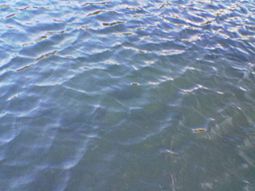Freshwater
- For other uses, see Freshwater (disambiguation).
A term that refers to bodies of water such as ponds, lakes, rivers and streams containing low concentrations of dissolved salts and other total dissolved solids. Freshwater is an important renewable resource, necessary for the survival of most terrestrial organisms, and is required by humans for drinking and agriculture, among many other uses. The UN estimates that about 1.2 billion people (18 percent of the world's population) lack access to safe drinking water.[1]
Numerical definition
Freshwater is defined as water with less than 0.5 parts per thousand dissolved salts.[1] Freshwater bodies include lakes and ponds, rivers, some bodies of underground water and many kinds of man-made freshwater bodies, such as canals, ditches and reservoirs. The ultimate source of freshwater is the precipitation of atmosphere in the form of rain and snow.
| Water salinity based on dissolved salts in parts per thousand (ppt) | |||
|---|---|---|---|
| Freshwater | Brackish water | Saline water | Brine |
| < 0.5 | 0.5 - 35 | 35 - 50 | > 50 |
Water distribution
Access to unpolluted freshwater is a critical issue for the survival of many species, including humans, who must drink freshwater in order to survive. Only three percent of the water on Earth is freshwater in nature, and about two-thirds of this is frozen in glaciers and polar ice caps. Most of the rest is underground and only 0.3 percent is surface water. Freshwater lakes, most notably Lake Baikal in Russia and the Great Lakes in North America, contain seven-eighths of this fresh surface water. Swamps have most of the balance with only a small amount in rivers, most notably the Amazon River. The atmosphere contains 0.04% water. [2] In areas with no freshwater on the ground surface, freshwater derived from precipitation may, because of its lower density, overlie saline ground water in lenses or layers.
Aquatic organisms
Freshwater creates a hypotonic environment for aquatic organisms. This is problematic for some organisms, whose cell membranes will burst if excess water is not excreted. Some protists accomplish this using Contractile vacuoles, while freshwater fish excrete excess water via the kidney.[3] Although most aquatic organisms have a limited ability to regulate their osmotic balance and therefore can only live within a narrow range of salinity, diadromous fish have the ability to migrate between freshwater and saline water bodies. During these migrations they undergo changes to adapt to the surroundings of the changed salinities; these processes are hormonally controlled. The eel (Anguilla anguilla) uses the hormone prolactin, while in salmon (Salmo salar) the hormone cortisol plays a key role during this process.
See also
- Desalination
- Limnology
- Seawater
- Water (molecule)
- Water cycle
- Water resources
- Water crisis
ReferencesISBN links support NWE through referral fees
- ↑ Groundwater Glossary (2006-03-27). Retrieved 2006-05-14.
- ↑ Gleick, Peter and et al. (1996). in Stephen H. Schneider: Encyclopedia of Climate and Weather. Oxford University Press.
- ↑ Vertebrate Kidneys (2002-11-03). Retrieved 2006-05-14.
The Groundwater Foundation. 2008. Groundwater glossary
Environmental Protection Agency (EPA), United States. 2007. Freshwater ecosystems. http://www.epa.gov/bioiweb1/aquatic/freshwater.html
Office of Naval Research. n.d. Ocean water: Salinity
University of California Museum of Paleontology (USMP). n.d. The freshwater biome.
University Corporation for Atmospheric Research (UCAR). 2002. Salinity - Dissolved Salts, Measuring Salinity Regents of the University of Michigan.
External links
- Freshwater life.org
- Freshwater Biological Association
- Review of freshwater ecology in the UK
- UK Government Environmental Agency website
- Pond Conservation
- UK National pond monitoring network
Credits
New World Encyclopedia writers and editors rewrote and completed the Wikipedia article in accordance with New World Encyclopedia standards. This article abides by terms of the Creative Commons CC-by-sa 3.0 License (CC-by-sa), which may be used and disseminated with proper attribution. Credit is due under the terms of this license that can reference both the New World Encyclopedia contributors and the selfless volunteer contributors of the Wikimedia Foundation. To cite this article click here for a list of acceptable citing formats.The history of earlier contributions by wikipedians is accessible to researchers here:
The history of this article since it was imported to New World Encyclopedia:
Note: Some restrictions may apply to use of individual images which are separately licensed.
